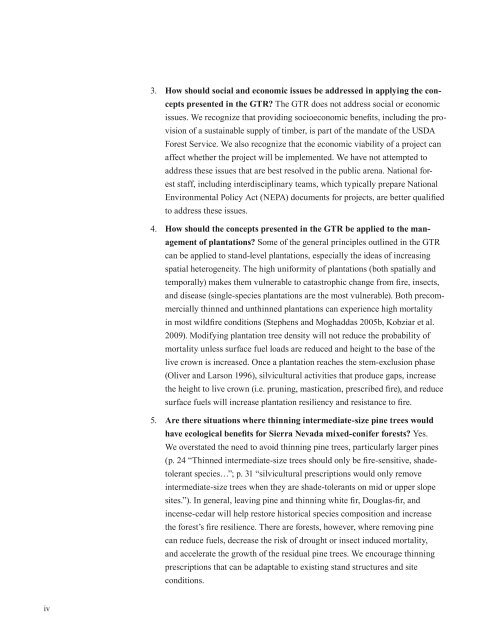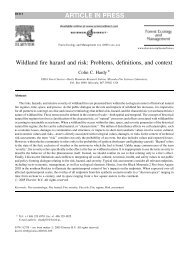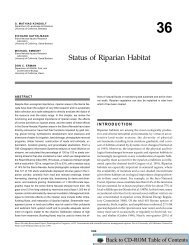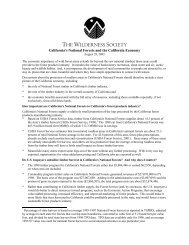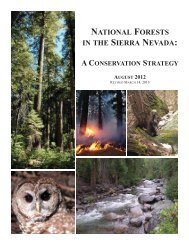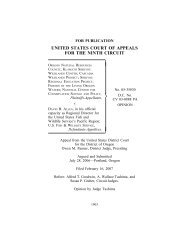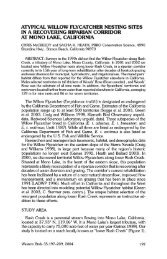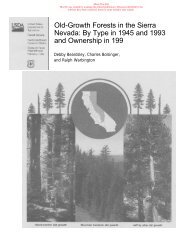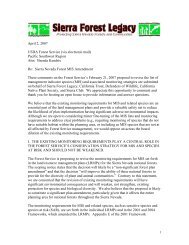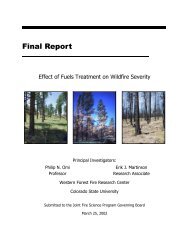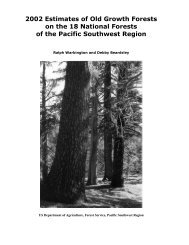An Ecosystem Management Strategy for Sierran Mixed-Conifer Forests
An Ecosystem Management Strategy for Sierran Mixed-Conifer Forests
An Ecosystem Management Strategy for Sierran Mixed-Conifer Forests
You also want an ePaper? Increase the reach of your titles
YUMPU automatically turns print PDFs into web optimized ePapers that Google loves.
3. How should social and economic issues be addressed in applying the concepts<br />
presented in the GTR? The GTR does not address social or economic<br />
issues. We recognize that providing socioeconomic benefits, including the provision<br />
of a sustainable supply of timber, is part of the mandate of the USDA<br />
Forest Service. We also recognize that the economic viability of a project can<br />
affect whether the project will be implemented. We have not attempted to<br />
address these issues that are best resolved in the public arena. National <strong>for</strong>est<br />
staff, including interdisciplinary teams, which typically prepare National<br />
Environmental Policy Act (NEPA) documents <strong>for</strong> projects, are better qualified<br />
to address these issues.<br />
4. How should the concepts presented in the GTR be applied to the management<br />
of plantations? Some of the general principles outlined in the GTR<br />
can be applied to stand-level plantations, especially the ideas of increasing<br />
spatial heterogeneity. The high uni<strong>for</strong>mity of plantations (both spatially and<br />
temporally) makes them vulnerable to catastrophic change from fire, insects,<br />
and disease (single-species plantations are the most vulnerable). Both precommercially<br />
thinned and unthinned plantations can experience high mortality<br />
in most wildfire conditions (Stephens and Moghaddas 2005b, Kobziar et al.<br />
2009). Modifying plantation tree density will not reduce the probability of<br />
mortality unless surface fuel loads are reduced and height to the base of the<br />
live crown is increased. Once a plantation reaches the stem-exclusion phase<br />
(Oliver and Larson 1996), silvicultural activities that produce gaps, increase<br />
the height to live crown (i.e. pruning, mastication, prescribed fire), and reduce<br />
surface fuels will increase plantation resiliency and resistance to fire.<br />
5. Are there situations where thinning intermediate-size pine trees would<br />
have ecological benefits <strong>for</strong> Sierra Nevada mixed-conifer <strong>for</strong>ests? Yes.<br />
We overstated the need to avoid thinning pine trees, particularly larger pines<br />
(p. 24 “Thinned intermediate-size trees should only be fire-sensitive, shadetolerant<br />
species…”; p. 31 “silvicultural prescriptions would only remove<br />
intermediate-size trees when they are shade-tolerants on mid or upper slope<br />
sites.”). In general, leaving pine and thinning white fir, Douglas-fir, and<br />
incense-cedar will help restore historical species composition and increase<br />
the <strong>for</strong>est’s fire resilience. There are <strong>for</strong>ests, however, where removing pine<br />
can reduce fuels, decrease the risk of drought or insect induced mortality,<br />
and accelerate the growth of the residual pine trees. We encourage thinning<br />
prescriptions that can be adaptable to existing stand structures and site<br />
conditions.<br />
iv


